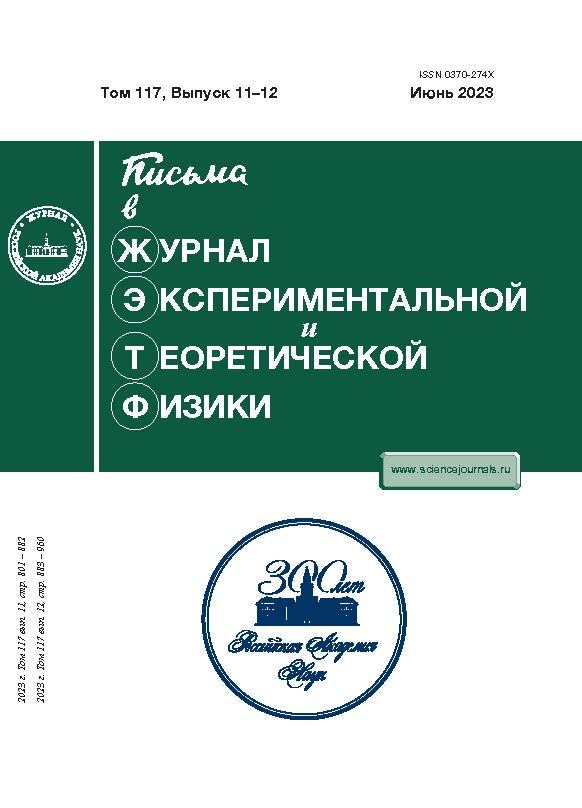Energy Spectrum of β Electrons in Neutrinoless Double-β Decay Including the Excitation of the Electron Shell of Atoms
- 作者: Krivoruchenko M.I1, Tyrin K.S1, Karpeshin F.F2
-
隶属关系:
- National Research Center Kurchatov Institude, 123182, Moscow, Russia
- Mendeleev All-Russia Institute for Metrology, 190005, St. Petersburg, Russia
- 期: 卷 117, 编号 11-12 (6) (2023)
- 页面: 887-891
- 栏目: Articles
- URL: https://vestnik.nvsu.ru/0370-274X/article/view/663152
- DOI: https://doi.org/10.31857/S1234567823120029
- EDN: https://elibrary.ru/EUTANO
- ID: 663152
如何引用文章
详细
Double-β decay is accompanied with a high probability by the excitation of the electron shell of the daughter atom; as a result, the energy carried away by β electrons decreases. The mean value and standard deviation of the excitation energy of the electron shell of the daughter atom in the double-β decay of germanium
have been determined within the Thomas–Fermi and relativistic Dirac–Hartree–Fock methods. Using the estimates thus obtained, a two-parameter model of the energy spectrum of β electrons in the neutrinoless mode has been developed including the redistribution of the reaction energy between the decay products. The shift of the total energy of β electrons does not exceed 50 eV with a probability of 90%. However, the mean excitation energy is ~400 eV, i.e., an order of magnitude higher, whereas the standard deviation is ~2900 eV, which is apparently due to a significant contribution from inner electron levels to the energy characteristics of the process. The distortion of the shape of the peak of the 0ν2β decay should be taken into account when analyzing the data of detectors with a resolution of ~100 eV or higher.
作者简介
M. Krivoruchenko
National Research Center Kurchatov Institude, 123182, Moscow, Russia
Email: mikhail.krivoruchenko@itep.ru
K. Tyrin
National Research Center Kurchatov Institude, 123182, Moscow, Russia
Email: mikhail.krivoruchenko@itep.ru
F. Karpeshin
Mendeleev All-Russia Institute for Metrology, 190005, St. Petersburg, Russia
编辑信件的主要联系方式.
Email: mikhail.krivoruchenko@itep.ru
参考
- S. Bilenky, Introduction to the Physics of Massive and Mixed Neutrinos, 2nd ed., Lecture Notes in Physics, Springer-Verlag, Berlin (2018), v. 947.
- W. Bambynek, H. Behrens, M.H. Chen, B. Crasemann, M. L. Fitzpatrick, K.W.D. Ledingham, H. Genz, M. Mutterer, and R. L. Intemann, Rev. Mod. Phys. 49, 77 (1977).
- M. I. Krivoruchenko and K. S. Tyrin, Eur. Phys. J. A 56, 16 (2020).
- F. F. Karpeshin, M. B. Trzhaskovskaya, and L. F. Vitushkin, Yad. Fiz. 83, 344 (2020)
- Phys. At. Nucl. 83, 608 (2020).
- F. F. Karpeshin and M.B. Trzhaskovskaya, Yad. Fiz. 85, 347 (2022)
- Phys. At. Nucl. 85, 474 (2022).
- F. F. Karpeshin and M.B. Trzhaskovskaya, Phys. Rev. C 107, 045502 (2023).
- I. Lindgren, Journal of Electron Spectroscopy and Related Phenomena 137-140, 59 (2004).
- K. Alfonso, D.R. Artusa, F.T. Avignone et al. (CUORE Collaboration), Phys. Rev. Lett. 115, 102502 (2015).
- G. Anton, I. Badhrees, P. S. Barbeau et al. (EXO-200 Collaboration), Phys. Rev. Lett. 123, 161802 (2019).
- A. Gando, Y. Gando, T. Hachiya et al. (KamLAND-Zen Collaboration), Phys. Rev. Lett. 117, 082503 (2016)
- Addendum: Phys. Rev. Lett. 117, 109903 (2016).
- R. Arnold, C. Augier, J.D. Baker et al. (NEMO-3 Collaboration), Phys. Rev. D 92, 072011 (2015).
- The GERDA Collaboration, Nature 544, 47 (2017).
- J.T. Suhonen, Front. Phys. 5, 55 (2017).
- F. ˇSimkovic, A. Faessler, V. Rodin, P. Vogel, and J. Engel, Phys. Rev. C 77, 045503 (2008).
- C.C. Lu, T.A. Carlson, F.B. Malik, T.C. Tucker, and C.W. Nestor, Jr., At. Data Nucl. Data Tables 3, 1 (1971).
- J. P. Desclaux, At. Data Nucl. Data Tables 12, 31l (1973).
- E. Clementi and C. Roetti, At. Data Nucl. Data Tables 14, 177 (1974).
- K.-N. Huang, M. Aoyagi, M.H. Chen, B. Grasemann, and H. Mark, At. Data Nucl. Data Tables 18, 243 (1976).
- K.G. Dyall, I.P. Grant, C.T. Johnson, F.A. Parpia, and E. P. Blummer, Comput. Phys. Commun. 55, 425 (1989).
- I.P. Grant, Relativistic Quantum Theory of Atoms and Molecules: Theory and Computation, Springer Science + Business Media, N.Y. (2007).
- L.D. Landau and E.M. Lifschitz, Quantum Mechanics: Non-relativistic Theory. Course of Theoretical Physics, 3rd ed., Pergamon, London (1977), v. 3.
- A. Kramida and Yu. Ralchenko, J. Reader and NIST ASD Team (2022), NIST Atomic Spectra Database (ver. 5.10), https://physics.nist.gov/asd
- National Institute of Standards and Technology, Gaithersburg, MD; DOI: https://doi.org/10.18434/T4W30F
- J.C. Mason, Math. Proc. Cambridge Philos. Soc. 84, 357-360 (1964).
- I.M. Band, M. B. Trzhaskovskaya, C.W. Nestor Jr., P.O. Tikkanen, and S. Raman, At. Data Nucl. Data Tables 81, 1 (2002).
- I.M. Band and M.B. Trzhaskovskaya, At. Data Nucl. Data Tables 35, 1 (1986).
- E. L. Feinberg, J. Phys. (USSR) 4, 423 (1941).
- A. Мигдал, ЖЭТФ 11, 207 (1941)
- A. Migdal, J. Phys. Acad. Sci. USSR 4(1-6), 449 (1941).
- Z. Ge, T. Eronen, K. S. Tyrin, J. Kotila et al., Phys. Rev. Lett. 127, 272301 (2021).
- В.С. Королюк, Н.И. Портенко, А.В. Скороход, А.Ф. Турбин, Справочник по теории вероятностей и математической статистике, Наука M. (1985), 640 с.
补充文件









